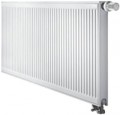Country of origin
The country of origin of the brand.
In most cases, either the homeland of the brand or the location of the manufacturer's headquarters is indicated as the country of origin. Production facilities may well be located in another country. However, it is worth noting here that most of the national stereotypes nowadays are unfounded — the quality of products depends not so much on geography but on the characteristics of the organization of the production process in a particular company. So from this point of view, when choosing, you should focus primarily on the reputation of a particular manufacturer. It makes sense to pay attention to the country of origin of the brand if you fundamentally want (or do not want) to support a company from a certain state.
Nowadays, the production of radiators is mainly carried out by companies from such countries:
England,
Belarus,
Belgium,
Germany,
Holland,
Spain,
Italy,
China,
Norway,
Poland,
Turkey,
Ukraine,
Finland,
Czech Republic.
Heat transfer medium volume
The volume of water or other heating medium required to fill the radiator.
This information is relevant mainly when building an autonomous heating system: it is useful when calculating the total volume of heating medium in the system and related parameters. If the radiator is purchased for use in centralized heating, you can not pay much attention to its internal volume.
Connection size
The diameter of the thread used to connect the radiator to the heating system. Modern radiators use standard sizes — for example,
3/4" or
1/2", less often
1" and
1 1/4". This indicator must match the dimensions of the pipes, couplings and other elements directly used for connection — otherwise, at best, you will need to install adapters, and at worst, the radiator will turn out to be unusable at all.
Usually, the larger the thread diameter, the more powerful the radiator (high power requires intensive circulation of the heating medium and an appropriate throughput at the inlet and outlet).
Heat output
The rated thermal output of the radiator is the amount of heat given off to the air in normal operation.
When choosing this parameter note that the heat output will depend on the temperature difference at the inlet and outlet to the radiator, as well as on the ambient temperature. The greater the temperature difference and the colder it is around, the more intense the heating will be. Therefore, in the specs, it is customary to indicate heat transfer for certain standard conditions. In particular, the designation according to the European standard EN-442 is very popular, which assumes heating medium temperatures of +75 °С and +65 °С at the inlet and outlet, respectively, as well as an air temperature of +20 °С. Real conditions and the actual heat output of the radiator may differ; therefore, when choosing, it is best to choose a model with a certain margin and compensate for excess power with one or another regulator. As for the actual values, in the most modest models, the heat output
does not exceed 750 W, or even
500 W, and in the largest, this figure can reach
3.5 – 4 kW or
more.
The choice for this parameter depends primarily on the size and specs of the heated space. The simplest calculation formula is as follows: at least 100 W of thermal power is required per 1 m2 of area. This formula is relevant for standard r
...esidential/office premises with ceilings of 2.5 – 3 m, without problems with thermal insulation; for more specific conditions, there are more detailed calculation methods, that can be found in special sources.Radiator depth
The size of the radiator from the front to the back wall.
This parameter determines both the size of the space occupied by the device and its efficiency: other things being equal, a greater depth means a higher heat output (due to an increase in the area of contact with air). Specific nuances depend on the type of radiator and the method of its installation (see above). So, the most critical depth is for convectors with a horizontal layout, mounted in a niche — in them, this size directly determines both the required dimensions of the niche and the area of the working surface. In column models, this dependence is somewhat less pronounced. In panel devices, the efficiency depends not so much on the depth as such, but on the number of working elements (see "Type (panel)") — although a larger number of panels/convectors inevitably affects the dimensions. And sectional radiators most often have a relatively small depth: the differences between them in this parameter are not fundamental.

